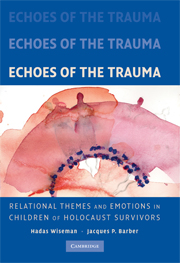Book contents
- Frontmatter
- Contents
- Foreword by Dan Bar-On
- Preface
- Acknowledgments
- 1 Introduction – A Narrative Approach to Bridging the Gap between Clinical Case Studies and Empirical Research on Children of Holocaust Survivors
- 2 Studying Relationship Narratives with the Core Conflictual Relationship Theme Method
- PART ONE RELATIONAL THEMES IN THE NARRATIVES
- PART TWO EMOTIONS IN THE NARRATIVES
- 6 Anger
- 7 Guilt, Shame, and Embarrassment
- 8 Anxiety and Helplessness
- 9 Loneliness
- 10 Joy and Pride
- PART THREE HEALING TRAUMA IN THE CHAIN OF THE GENERATIONS
- Appendix
- References
- Index
7 - Guilt, Shame, and Embarrassment
Published online by Cambridge University Press: 29 July 2009
- Frontmatter
- Contents
- Foreword by Dan Bar-On
- Preface
- Acknowledgments
- 1 Introduction – A Narrative Approach to Bridging the Gap between Clinical Case Studies and Empirical Research on Children of Holocaust Survivors
- 2 Studying Relationship Narratives with the Core Conflictual Relationship Theme Method
- PART ONE RELATIONAL THEMES IN THE NARRATIVES
- PART TWO EMOTIONS IN THE NARRATIVES
- 6 Anger
- 7 Guilt, Shame, and Embarrassment
- 8 Anxiety and Helplessness
- 9 Loneliness
- 10 Joy and Pride
- PART THREE HEALING TRAUMA IN THE CHAIN OF THE GENERATIONS
- Appendix
- References
- Index
Summary
The narratives in this chapter focus on the echoes of trauma as reflected in the dynamics of interpersonal guilt in relation to the survivor parents and in the emotional experiences of shame and em- barrassment. The literature groups social emotions into four broad interpersonal clusters: affectionate, self-conscious, melancholic, and hostile. It has been suggested that these four clusters are embedded within social contexts and help shape and define the nature of close relationships (Guerrero & Andersen, 2000). The “self-conscious” emotions of guilt, shame, embarrassment, and pride are deemed particularly social in nature because they tend to occur in interpersonal or public contexts. The first three emotions are discussed in this chapter; pride is considered in the chapter on positive emotions. Here we delineate certain narratives according to the predominant self-conscious emotion in them (guilt or shame and embarrassment), although some of the recounted experiences clearly involved more than one.
GUILT
In contrast to traditional theories that depict guilt as an intrapersonal phenomenon based on self-judgment, contemporary researchers on emotions (e.g., Baumeister, Stillwell, & Heatherton, 1995; Jones, Kugler, & Adams, 1995) view guilt as an interpersonal phenomenon found in close relationships. According to this view, people may indeed experience guilt when they are alone, but the actual source of this unpleasant emotion is primarily interpersonal worries and problems (Baumeister, Reis, & Delespal, 1995) or interpersonal situations and relationships (Tangney, 1992).
- Type
- Chapter
- Information
- Echoes of the TraumaRelational Themes and Emotions in Children of Holocaust Survivors, pp. 118 - 132Publisher: Cambridge University PressPrint publication year: 2008



